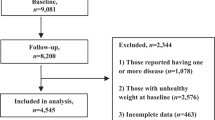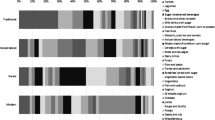Abstract
Objectives:
To investigate the associations of dietary factors with overweight, body fat percentage (BF%), waist circumference (WC) and hip circumference (HC) among children.
Design:
Cross-sectional analysis of the Physical Activity and Nutrition in Children (PANIC) Study among 510 children (263 boys, 247 girls) aged 6–8 years from Kuopio, Finland.
Methods:
The children’s weight, height, WC and HC were measured. Overweight was defined by International Obesity Task Force body mass index cutoffs. The BF% was measured by dual-energy X-ray absorptiometry, nutrient intakes and meal frequency by 4-day food records and eating behaviour by Children’s Eating Behaviour Questionnaire.
Results:
Daily consumption of all the three main meals was inversely associated with overweight (odds ratio (OR) 0.37, 95% confidence interval (CI) 0.18–0.75), BF% (β −0.12, P=0.012), WC (β −0.16, P=0.002) and HC (β −0.15, P=0.002). Enjoyment of food, food responsiveness and emotional overeating were directly associated with overweight (OR 1.57, 95% CI 1.04–2.35; OR 4.68, 95% CI 2.90–7.54; OR 2.60, 95% CI 1.52–4.45, respectively), BF% (β 0.13, P=0.004; β 0.30, P<0.001; β 0.09, P=0.035, respectively), WC (β 0.14, P=0.003; β 0.40, P<0.001; β 0.19, P<0.001, respectively) and HC (β 0.15, P=0.001; β 0.38, P<0.001; β 0.15, P=0.001, respectively). Satiety responsiveness was inversely associated with overweight (OR 0.42, 95% CI 0.26–0.67), BF% (β −0.20, P<0.001), WC (β −0.26, P<0.001) and HC (β −0.26, P<0.001). Slowness in eating was inversely associated with overweight (OR 0.61, 95% CI 0.41–0.92), WC (β −0.16, P=0.001) and HC (β −0.17, P<0.001). Protein intake was directly associated with BF% (β 0.11, P=0.017), WC (β 0.11, P=0.020) and HC (β 0.13, P=0.008).
Conclusions:
Promoting regular consumption of main meals and healthy eating behaviours should be emphasized in the prevention of overweight among children. More research is needed on the association of protein-rich foods with body adiposity in children.
This is a preview of subscription content, access via your institution
Access options
Subscribe to this journal
Receive 12 print issues and online access
$259.00 per year
only $21.58 per issue
Buy this article
- Purchase on Springer Link
- Instant access to full article PDF
Prices may be subject to local taxes which are calculated during checkout
Similar content being viewed by others
References
Janssen I, Katzmarzyk PT, Boyce WF, Vereecken C, Mulvihill C, Roberts C et al. Comparison of overweight and obesity prevalence in school-aged youth from 34 countries and their relationships with physical activity and dietary patterns. Obes Rev 2005; 6: 123–132.
de Onis M, Blossner M, Borghi E . Global prevalence and trends of overweight and obesity among preschool children. Am J Clin Nutr 2010; 92: 1257–1264.
Kautiainen S, Rimpela A, Vikat A, Virtanen SM . Secular trends in overweight and obesity among Finnish adolescents in 1977-1999. Int J Obes Relat Metab Disord 2002; 26: 544–552.
Vuorela N, Saha MT, Salo M . Prevalence of overweight and obesity in 5- and 12-year-old Finnish children in 1986 and 2006. Acta Paediatr 2009; 98: 507–512.
Arenz S, Ruckerl R, Koletzko B, von Kries R . Breast-feeding and childhood obesity--a systematic review. Int J Obes Relat Metab Disord 2004; 28: 1247–1256.
Reilly JJ, Armstrong J, Dorosty AR, Emmett PM, Ness A, Rogers I et al. Early life risk factors for obesity in childhood: cohort study. BMJ 2005; 330: 1357.
Danielzik S, Czerwinski-Mast M, Langnase K, Dilba B, Muller MJ . Parental overweight, socioeconomic status and high birth weight are the major determinants of overweight and obesity in 5-7 y-old children: baseline data of the Kiel Obesity Prevention Study (KOPS). Int J Obes Relat Metab Disord 2004; 28: 1494–1502.
Must A, Tybor DJ . Physical activity and sedentary behavior: a review of longitudinal studies of weight and adiposity in youth. Int J Obes (Lond) 2005; 29 (Suppl 2): S84–S96.
Kleiser C, Schaffrath Rosario A, Mensink GB, Prinz-Langenohl R, Kurth BM . Potential determinants of obesity among children and adolescents in Germany: results from the cross-sectional KiGGS Study. BMC Public Health 2009; 9: 46.
Rodriguez G, Moreno LA . Is dietary intake able to explain differences in body fatness in children and adolescents? Nutr Metab Cardiovasc Dis 2006; 16: 294–301.
Moreno LA, Rodriguez G . Dietary risk factors for development of childhood obesity. Curr Opin Clin Nutr Metab Care 2007; 10: 336–341.
Maffeis C, Provera S, Filippi L, Sidoti G, Schena S, Pinelli L et al. Distribution of food intake as a risk factor for childhood obesity. Int J Obes Relat Metab Disord 2000; 24: 75–80.
Maillard G, Charles MA, Lafay L, Thibult N, Vray M, Borys JM et al. Macronutrient energy intake and adiposity in non obese prepubertal children aged 5-11 y (the Fleurbaix Laventie Ville Sante Study). Int J Obes Relat Metab Disord 2000; 24: 1608–1617.
Johnson L, Mander AP, Jones LR, Emmett PM, Jebb SA . Energy-dense low-fiber, high-fat dietary pattern is associated with increased fatness in childhood. Am J Clin Nutr 2008; 87: 846–854.
Wilson TA, Adolph AL, Butte NF . Nutrient adequacy and diet quality in non-overweight and overweight Hispanic children of low socioeconomic status: the Viva la Familia Study. J Am Diet Assoc 2009; 109: 1012–1021.
Elliott SA, Truby H, Lee A, Harper C, Abbott RA, Davies PS . Associations of body mass index and waist circumference with: energy intake and percentage energy from macronutrients, in a cohort of Australian children. Nutr J 2011; 10: 58.
Nicklas TA, Yang SJ, Baranowski T, Zakeri I, Berenson G . Eating patterns and obesity in children. The Bogalusa Heart Study. Am J Prev Med 2003; 25: 9–16.
Toschke AM, Thorsteinsdottir KH, von Kries R . GME Study Group. Meal frequency, breakfast consumption and childhood obesity. Int J Pediatr Obes 2009; 4: 242–248.
Sandercock GR, Voss C, Dye L . Associations between habitual school-day breakfast consumption, body mass index, physical activity and cardiorespiratory fitness in English schoolchildren. Eur J Clin Nutr 2010; 64: 1086–1092.
Sleddens EF, Kremers SP, Thijs C . The Children's Eating Behaviour Questionnaire: factorial validity and association with Body Mass Index in Dutch children aged 6-7. Int J Behav Nutr Phys Act 2008; 5: 49.
Viana V, Sinde S, Saxton JC . Children's Eating Behaviour Questionnaire: associations with BMI in Portuguese children. Br J Nutr 2008; 100: 445–450.
Webber L, Hill C, Saxton J, Van Jaarsveld CH, Wardle J . Eating behaviour and weight in children. Int J Obes (Lond) 2009; 33: 21–28.
Spence JC, Carson V, Casey L, Boule N . Examining behavioural susceptibility to obesity among Canadian pre-school children: the role of eating behaviours. Int J Pediatr Obes 2011; 6: e501–e507.
Cole TJ, Freeman JV, Preece MA . Body mass index reference curves for the UK, 1990. Arch Dis Child 1995; 73: 25–29.
Freeman JV, Cole TJ, Chinn S, Jones PR, White EM, Preece MA . Cross sectional stature and weight reference curves for the UK, 1990. Arch Dis Child 1995; 73: 17–24.
Cole TJ, Bellizzi MC, Flegal KM, Dietz WH . Establishing a standard definition for child overweight and obesity worldwide: international survey. BMJ 2000; 320: 1240–1243.
Rastas M, Seppänen R, Knuts LR, Hakala P, Karttila V (eds) Nutrient Composition of Foods. The Social Insurance Institution: Helsinki, France, 1997.
Wardle J, Guthrie CA, Sanderson S, Rapoport L . Development of the Children's Eating Behaviour Questionnaire. J Child Psychol Psychiatry 2001; 42: 963–970.
de Gouw L, Klepp KI, Vignerova J, Lien N, Steenhuis IH, Wind M . Associations between diet and (in) activity behaviours with overweight and obesity among 10-18-year-old Czech Republic adolescents. Public Health Nutr 2010; 13: 1701–1707.
Lehto R, Ray C, Lahti-Koski M, Roos E . Meal pattern and BMI in 9-11-year-old children in Finland. Public Health Nutr 2011; 14: 1245–1250.
Berkowitz RI, Moore RH, Faith MS, Stallings VA, Kral TV, Stunkard AJ . Identification of an obese eating style in 4-year-old children born at high and low risk for obesity. Obesity (Silver Spring) 2010; 18: 505–512.
Ashcroft J, Semmler C, Carnell S, van Jaarsveld CH, Wardle J . Continuity and stability of eating behaviour traits in children. Eur J Clin Nutr 2008; 62: 985–990.
Carnell S, Wardle J . Appetitive traits in children. New evidence for associations with weight and a common, obesity-associated genetic variant. Appetite 2009; 53: 260–263.
Rolland-Cachera MF, Deheeger M, Akrout M, Bellisle F . Influence of macronutrients on adiposity development: a follow up study of nutrition and growth from 10 months to 8 years of age. Int J Obes Relat Metab Disord 1995; 19: 573–578.
Gunnarsdottir I, Thorsdottir I . Relationship between growth and feeding in infancy and body mass index at the age of 6 years. Int J Obes Relat Metab Disord 2003; 27: 1523–1527.
Gunther AL, Buyken AE, Kroke A . Protein intake during the period of complementary feeding and early childhood and the association with body mass index and percentage body fat at 7 y of age. Am J Clin Nutr 2007; 85: 1626–1633.
Newby PK . Are dietary intakes and eating behaviors related to childhood obesity? A comprehensive review of the evidence. J Law Med Ethics 2007; 35: 35–60.
Ruottinen S, Niinikoski H, Lagstrom H, Ronnemaa T, Hakanen M, Viikari J et al. High sucrose intake is associated with poor quality of diet and growth between 13 months and 9 years of age: the special Turku Coronary Risk Factor Intervention Project. Pediatrics 2008; 121: e1676–e1685.
Buzzard M . 24-h dietary recall and food record methods. In: Willett W (ed.) Nutritional Epidemiology. Oxford University Press: New York, 1998. pp 50.
Sopher AB, Thornton JC, Wang J, Pierson RN, Heymsfield SB, Horlick M . Measurement of percentage of body fat in 411 children and adolescents: a comparison of dual-energy X-ray absorptiometry with a four-compartment model. Pediatrics 2004; 113: 1285–1290.
Carnell S, Wardle J . Measuring behavioural susceptibility to obesity: validation of the child eating behaviour questionnaire. Appetite 2007; 48: 104–113.
Mäki P, Hakulinen-Viitanen T, Kaikkonen R, Koponen P, Ovaskainen M-L, Sippola R et al. (eds) [Child Health—Results of the LATE-study on growth, development, health, health behavior and growth environment]. In Finnish. National Institute for Health and Welfare (THL): Helsinki, 2010.
Acknowledgements
We thank all voluntary subjects and their families for participating in the PANIC Study. We are also gratefully indebted to the PANIC Study research team members for their skillful contribution in conducting the study. We gratefully acknowledge MD, PhD David Laaksonen for editing the language of the manuscript, Eila Koski for DXA scans and PhD Marja Kalavainen and PhD Outi Nuutinen for the translation of the Children’s Eating Behaviour Questionnaire into Finnish language. This work has been financially supported by grants from the Ministry of Social Affairs and Health of Finland, the Ministry of Education and Culture of Finland, the University of Eastern Finland, the Finnish Innovation Fund Sitra, the Social Insurance Institution of Finland, the Finnish Cultural Foundation, the Juho Vainio Foundation, the Foundation for Pediatric Research and the Kuopio University Hospital (EVO-funding number 5031343).
Author information
Authors and Affiliations
Corresponding author
Ethics declarations
Competing interests
The authors declare no conflict of interest.
Rights and permissions
About this article
Cite this article
Eloranta, AM., Lindi, V., Schwab, U. et al. Dietary factors associated with overweight and body adiposity in Finnish children aged 6–8 years: the PANIC Study. Int J Obes 36, 950–955 (2012). https://doi.org/10.1038/ijo.2012.89
Received:
Revised:
Accepted:
Published:
Issue Date:
DOI: https://doi.org/10.1038/ijo.2012.89
Keywords
This article is cited by
-
Cross-sectional and longitudinal associations between the 24-hour movement behaviours, including muscle and bone strengthening activity, with bone and lean mass from childhood to adolescence
BMC Public Health (2024)
-
Adherence to a healthy lifestyle behavior composite score and cardiometabolic risk factors in Spanish children from the CORALS cohort
European Journal of Pediatrics (2024)
-
Developmental models of motor-evoked potential features by transcranial magnetic stimulation across age groups from childhood to adulthood
Scientific Reports (2023)
-
Evidence for protein leverage in a general population sample of children and adolescents
European Journal of Clinical Nutrition (2023)
-
Associations of diet quality and food consumption with serum biomarkers for lipid and amino acid metabolism in Finnish children: the PANIC study
European Journal of Nutrition (2023)



